
There are a lot of discussions about how link stacking affects Google ranking. But many SEO practitioners don’t fully understand what link stacking is. SEOs often hear something works and they take off with it.
Few SEOs actually put it to the test.
It’s important as an SEO to question yourself the validity of things you hear or read about.
As SEOs, we have a tendency to believe everything we are told, purely because the source seems trustworthy: our colleagues, trusted sources in groups, and of course, Google itself.
Do you recall those good old days when Google was your best buddy? No?
This is why it’s so important to not jump into something just because someone said so. Even if that person is a well-known SEO guru.
Before modifying your link building strategy with this new information in mind, taking action based solely on popular opinion may not work out for you in the long term.
Many members have asked to see how link building stacks are set up. The requests are for specifics on certain steps or to see the actual mechanics of stacks.
To this point, we have not put complete stacks through a testing process from start to finish.
Here we go!
A page with a Google property pointing to it will rank higher than an equally optimized page that does not.
All tests contained five (5) pages of identically optimized content. The page that ranked in the 4th spot was the experiment page which allowed enough upward movement to give us some idea of how powerful (or not) the Google property is for passing power to the experiment page.

This test used an optimized Google doc linking to test page that ranks in the #4 spot.
The test page with the optimized Google link being sent to it rose up from number #4 to the #1 spot. The other urls have re-sorted, but now seems stable.
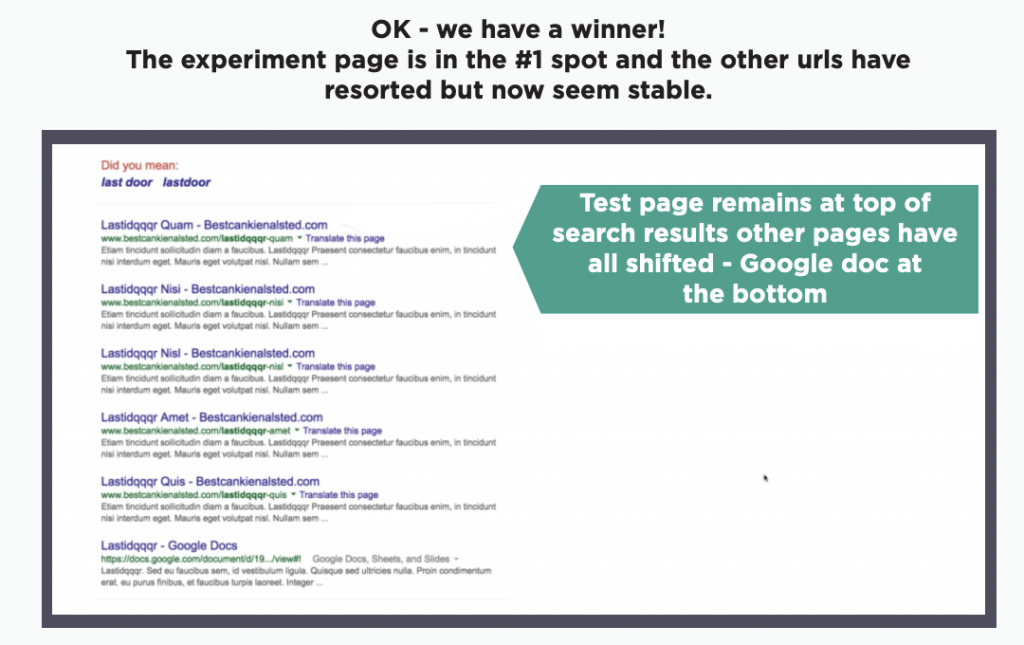
The results of this test is exciting. This confirms our previous test with Google
docs. In this test, we see a clear result of pointing a Google doc to a test page and
that it takes approx 5 days to “get its legs” to move up from #4 to the #1 spot.
This test used an optimized Google doc linking to test page that ranks in the #4 spot. Published and indexed through Google Search Console’s “Fetch” tool. Next, a YouTube video was created, optimized for the target keyword using YouTube’s editing tools.
A link was added to the experiment page in the description area of the video. The video was optimized by putting the target keyword in the description and in the comment, and by creating a playlist on the keyword.
A Google doc was created optimized for the target keyword. Now, both the YouTube video and the Google doc have a link back to the experiment page.
The 2 links of the video and Google doc were submitted for indexing via Google’s url submitter
For this test, the experiment page was gone and the other test pages are being dropped from the SERP.
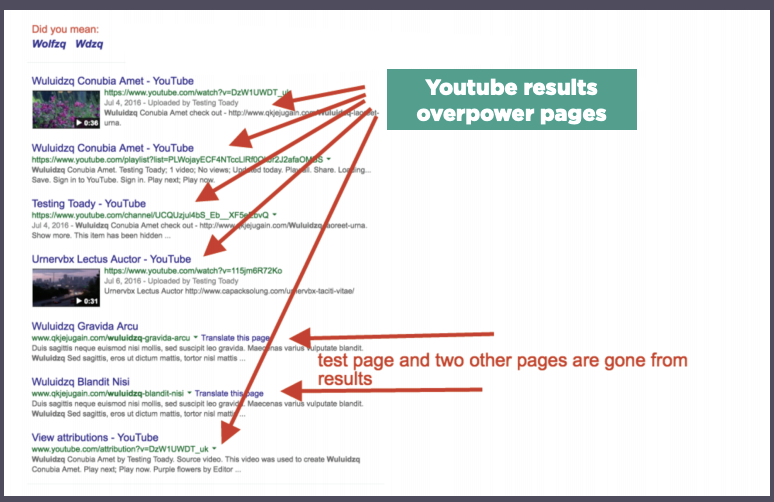
Clearly the YouTube property is powerful – and it’s not just the video url – but the
channel, the user, and the playlist.
What’s also concerning from the result of this test is the drop from rankings of
the experiment page. It’s possible that the two problems might be related. Using a regular url that contains the target keyword might create a strong association for videos and
channels that contain the target keyword causing those other properties to
pop out on a SERP with limited results.
At the same time, the ‘regular’ link from a YouTube video in conjunction with an exact match anchor text link from a Google doc might be a manipulation trigger.
5 equally optimized pages were created. All the links were published at the same time and submitted through Google’s Search Console using the “Fetch” tool.
Google properties were created using the same Gmail address:
All properties contained a link pointing to the experiment page.
A variation from the previous tests is that the YouTube video used a Google url shortener link.
The Google Doc contained a link to the experiment page within content anchor text.
The YouTube video was made using content from the Creative Commons library. In the description area, we placed a link to the experiment page using a link shortener.
For Google Drawing, the link to the experiment page was put in the drawing itself. The target keyword placed in the comment box.
For this test, the test page remained technically at #4, if you take out the youtube influence – then you could make the case it moved up 2 spots to the #2 spot of the pages
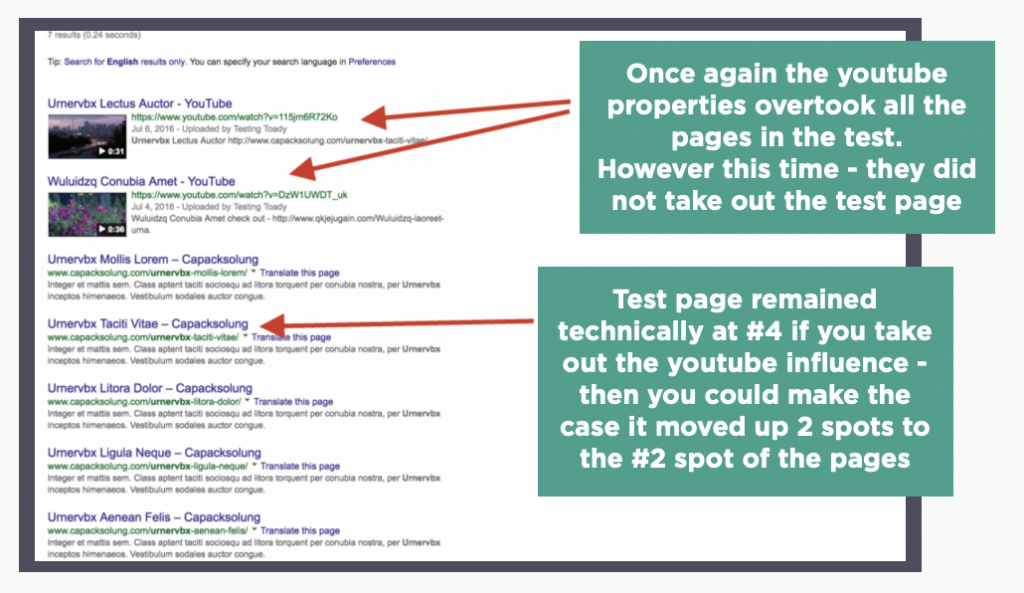
There’s lots to be gleaned from this test.
First, it’s super hard not to make more than one change or variable. Afterwards, we realized that we did not optimize the YouTube video as was done in the earlier tests. We accidentally left out the keyword in the description and in the comment, and did not create a separate playlist for the keyword.
With a less optimized video (accidentally), and using a shortener (intentionally), it’s
good to see that we’re getting positive results again.
One of the beautiful things about running a test is that it can help you think about
things in a way that you might not necessarily have thought before. After looking at
these tests, we’re wondering if a video possesses the “desire” to rank on its own.
As YouTube is owned by Google, they might have optimization elements built-in that will encourage rankings without any manipulation, but under the right conditions.
This test had a Google doc optimized for the target keyword link to the experiment page.
Instead of having the YouTube video link directly to the experiment page, this test stacked the video and linked it to Google doc.
The Google drawing and the Google Sheet, will point to the experiment page as they did in the previous tests.
Additionally, the YouTube video received less optimization, i.e the target keyword was only in the video title. The description area contained a link to the target page using a shortener.
For this test, the test page technically stayed in the same position but Youtube pushed it down to the #10 spot
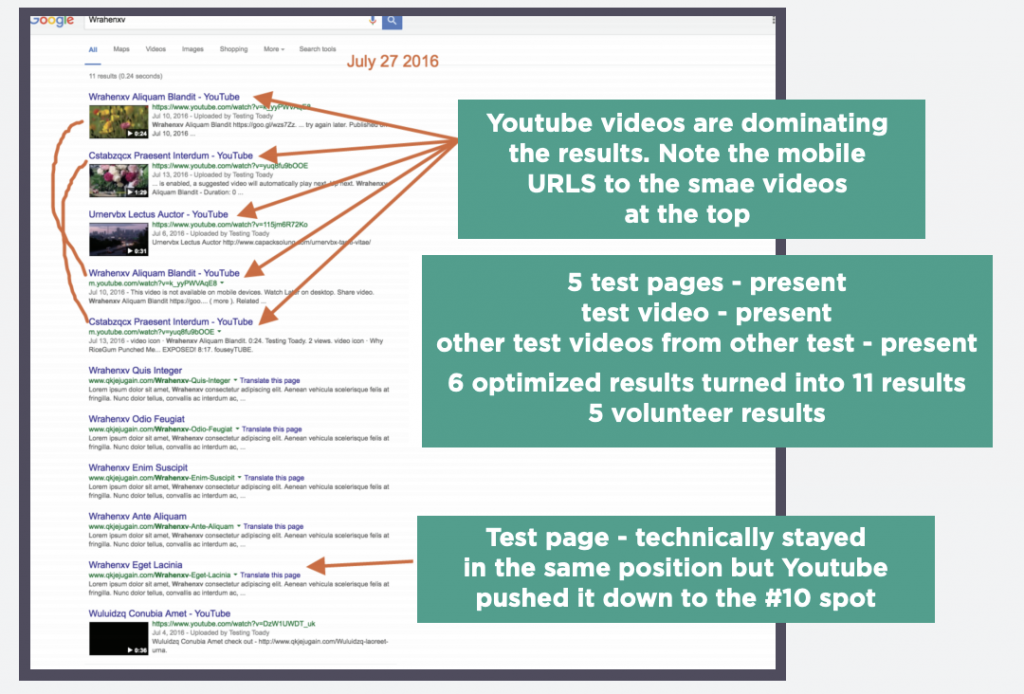
It seems that even if you don’t link the YouTube video directly to the experiment
page, a YouTube video is strong on its own and can take over your SERPs. While the
stack doesn’t seem to help drive power to the experiment page, at least in this test,
again, the experiment page was not deindexed.
In reviewing the previous tests, we’re getting the suspicion that having both a Google
doc and a YouTube video from the same Gmail account might be a trip wire for a
spam filter.
For this test, we looked to see if sending links from a Google docs and a YouTube video from two different accounts will be more beneficial than the links from the same properties from a single Gmail account.
The video settings remained the same from previous tests, i.e. keyword in the title, the link will be from a link shortener.
In this test, the test page continued to stay at #3. The Google shortener appears to have tampered YouTube’s ability to overpower the test pages and sent some power to move up the test page.

Part of this is good, something is telling Google not to rank the video over pages.
For the first time while using videos in these tests – the YouTube video did not rank
at the top over the other pages.
The Google shortener appears to have tampered YouTube’s ability to
overpower the test pages and sent some power to move up the test page.
In the next test, we’ll set the properties up using different Gmail accounts, but in
the next test we’ll space out the time.
It’s possible that the timing of the creation of the links makes a difference in how beneficial this Google doc linking concept works. Therefore, we’ll try it spacing out creating the links. Set up is similar to test 5 but for this, we built the Google doc first, then the Youtube video a week after.
For this test, the test page moved up from #4 spot to #3 spot. The video is not showing in the search results.
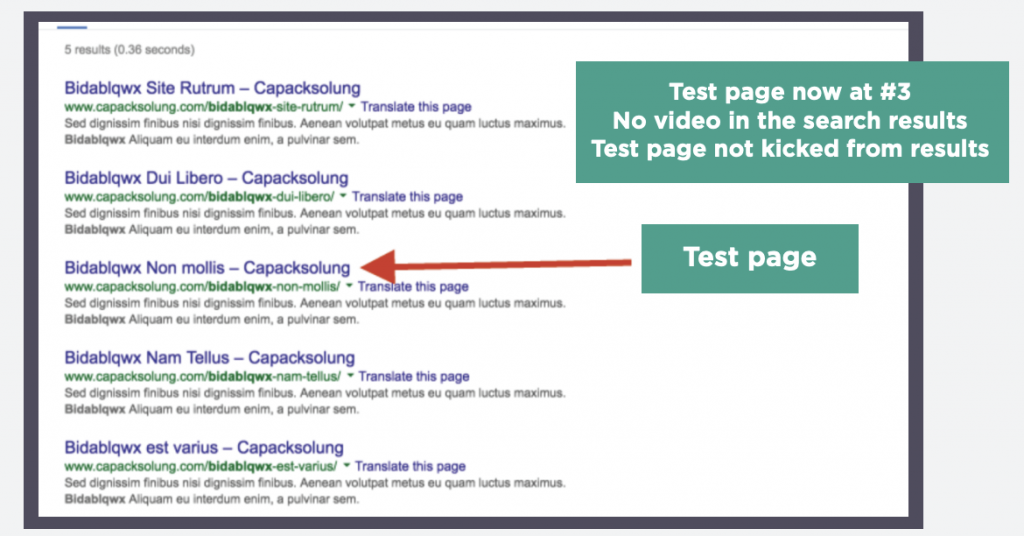
These are encouraging results as we have positive movement from these
properties. The results are still in flux a little bit and may alter a bit more. We’ll
keep an eye on things.
Nevertheless, after all these tests, it appears the safest play is to use different Gmail accounts when creating these properties and space out the time. We would put at least 5 days in between creating properties.
This is Test Number 46 on Google Stacks.
I want to illustrate the test and some of the test setup stuff. But I would caution you that the results of this test are probably significantly different now.
Just because of the way Google’s stacks are set up and how they now have to have permission set in order to actually mean anything for you.
A lot of people just flat out ignored it. Told them. Showed them. Flat out tested it multiple times. And they’re still ignoring it. They are still selling to the customers. They’re still selling garbage.
I tested this last year in 2020.
I will say this right off the bat just to save you guys some time, the way that these stacks were made would not work at all today.
Google has caught on to the Google Drive stack thing. They know that people are making software and they’re making all kinds of tools and stuff.
They’ve done something about that in order to eliminate the effectiveness of Google Drive stacks as link building platforms.
That being said…
There is still one way that’s still there.
There are some that are still able to leverage it, including some software.
Frankly, it’s not because they’re being smart. It’s just because if you build your stuff with the Google API, then it’ll pass juice because the settings on the folders and the documents will be proper.
If you build these manually, and you don’t have those proper settings, ie you haven’t created a folder with the API, and then manually build your stuff, you’re wasting your time.
They’re not passing juice. Google is on to you. Google has fixed it and it’s time to up your game.
The method to make these public may or may not go away in the future. And if you’re not prepared for that, you could be in a whole world of hurt.
If you have a way to make these things public from the web…
I’m giving you a hint right there, I haven’t released this much outside of the SIA, but I have talked about it.
If you make these public to the web, not available to anybody, they have to be public to the web. Only then will they pass juice.
Otherwise wasting your time.
Test #1: we actually did set up an optimized Google Doc.
I retested it now. It still works.
Test #2: Optimized Google Doc is test number two. Published through the Search Console fetch tool.
It created a YouTube video optimized for the keyword using Google YouTube editing tools, the link to the experiment pages in the description of the video.
This is a Google Doc that was created optimized for now both the Google Doc and the YouTube page link back to the experiment page.
That’s essentially two backlinks. That’s not necessarily a Google Drive stack, though. If you think about how those are all set up, it’s all the drive folders and they all interlink to each other.
There’s no mention of interlinking there.
That wouldn’t be a Google Drive stack. It would be just a link from Google properties, YouTube and Google Doc.
This one’s five automated pages. All the links were published at the same time. Properties were created using Google Drive, Google Drawing, and a video.
Google Drive and Google Drawing are a part of the Google Drive stack.
I did not add Google Drawing into my 2020 tests. It’s a good reminder, I need to do that and check that out.
That’s a Google Drawing, Google Doc and a YouTube video. Three links but not necessarily a stack because of the way that was written out.
I’m illustrating something here to you. As you progress through these tests, and we release them, we’re going to get to test 100.
Then I will release specific tests and then I won’t be releasing anymore.
And maybe we’ll do one or two tests a month for the YouTube communities outside of the SIA. Some of you just don’t want to buy the SIA membership. We get it for whatever reason.
I think you’re crazy. ;-D
But it’s your money and some of you just don’t want that but you do appreciate some of the free stuff that we can give out. And we’re more than happy to help out the community a little bit.
I’m illustrating something to you here.
IMPORTANT: if you’re going to do these tests, and you’re going to write this stuff up, and you’re gonna have a staff test for you, they need to know what wrong looks like.
In this case, we’re testing supposed Google Drive stacks. But we haven’t created the Google Drive stack yet, have we?
We’ve not actually done a real good stack. This is a Doc, Drawing, and Sheet and the video.
We’re getting a little bit closer.
But if those are not interlinked to each other, and the videos not linking to those, and those aren’t linked to the video, and then are all linking to the money site, we have not created a true stack.
So we’ll keep that going.
That’s Test #5.
Test #6. The results of page one. The experiment page number one spot as the Google Doc. The 2020 Google Doc did the same thing. When set up correctly.
Test #2. Experiment page is gone. The other test pages are being dropped from the SERPs. That is not necessarily an indication that the Google Docs is bad.
You have a YouTube video and a Google Doc, the Google Docs should have pushed that up but the experiment page is gone. There could be something wrong with the domains or that could be the first signs of Google filtering for multiple domains on a page.
That would be something that would have to be looked at right there.
Test page #4. If you take out the YouTube interference, and then you make a case for two spots… that one doesn’t even make any sense.
One, what is the youtube influence? You’re saying that? If you want to take out the YouTube influence as part of your test, why in the bejesus would you put YouTube in there in the first place?
And it went up two spots from the Google drawing in the Google Doc.
I think they’re assuming it, despite the fact that YouTube is there. So I don’t know what’s wrong with you, testers. Why did you do this one?
Test page technically stayed in the same position, but YouTube pushed it down to the 10th spot.
So if YouTube push it down to the 10th spot, guess what, it didn’t stay in the same position. YouTube to the page, hurt the website, hurt the page, and then the YouTube link actually took over in power.
And that’s what happened there, it wouldn’t technically stay the same.
Test page # 3. Google shortener appears to have hampered YouTube’s ability to overpower test pages and send some more power to the homepage.
That’s an interesting claim. If it stayed the same and all the test pages all had the same amount of power, and this one sent some power, then that wouldn’t have stayed the same.
That means that the Google shortener actually negated the authority that you’re getting out of the YouTube link that was probably in the description. Your page didn’t move.
Test page moved up from the number four spot to the number three spot. Video not showing in the search results.
And that’s the sixth one here. It was the beneficial link.
The Google Doc moved it up. And then they built all those other links and didn’t do any good after that.
That’s what I’m getting out of this.
If you read all of these, you technically really only need your Google Docs.
You don’t need the rest of them because you’re not getting any extra benefit out of them in this setup.
Again, not a Google stack. It’s titled a Google stack, but not a Google stack.
The next obvious step there is to individually check each one of these again:
– Google Docs
– Drawing
– Sheets
See what has the power to move a website.
See if you can build and identify a really good working combination, if you want to do that.
Or if you just want to go with the most powerful one and screw the rest, you can do that too.
And then move on from there and maybe play around with the variation. Drive and sheets. Docs and drawings. Drawings and sheets. And see if you get any benefit out of all that mess.
My test in 2020. This test in 2016. Google Docs is a way to go. Public to the web is a requirement.
I know this one is a little bit longer than the rest of them. And that is by design.
There was just so much wrong with this one. It had to be said. Because if you’re just reading it, you just won’t really get a whole out of it.
I wanted to point out the things that are wrong. The lessons here… just because they’re wrong, they’re not unnecessary lessons.
We need to know how to do this stuff so if you’re doing SEO testing, or you’re writing journals and monitoring what you’re doing, you need to clearly and concisely explain what you are doing.
This will help if you are trying to create an SOP out of it or train a new staff member, or teach a friend how to do some stuff for you, that it is all written down in clear and concise English.
When we come back to these 2016 tests – WOW, some of them are just rough.
We are getting better in the SIA!
This test is intended to help you understand how you can use Google properties to get more links to your site in the form of backlinks.
Using video, documents, spreadsheets and drawings are all great ways to get more backlinks to a site. But it has to be done properly.
This test was not set up properly and the point to it is to teach you what not to do.
If you want to learn more about link building, then we recommend reading our articles on link building.